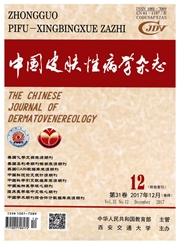

 中文摘要:
中文摘要:
目的研究低能量密度Q开关1064nmNd:YAG激光对小鼠皮肤屏障、基质金属蛋白酶的影响,探讨其嫩肤机制和最佳能量。方法分别用1,1.5和2J/cm。能量密度的激光照射BALB/c小鼠背部皮肤,光斑直径6ram,2次/周,连续4周,未照射组作为对照,分别于照射即刻,照射后7,14,21和28d时检测其皮肤弹性、皮肤水分及经皮水分丢失(TEWL)值、羟脯氨酸含量,定量PCR法和Westernblot法分别检测其基质金属蛋白酶(MMP)1和MMP9,Keratin-10(K-10)和Filaggrin水平。结果激光照射后即刻皮肤弹性下降,皮肤含水量仅在2J/cm。组上升,但照射7d后与对照比较无差异,从21d开始持续至28d,皮肤弹性、含水量和羟脯氨酸含量均明显增加,差异有统计学意义(P〈0.05)。照射后即刻持续至7d,TEwL明显增加,照射后7dK-10和Filaggrin明显减少,差异有统计学意义(P〈0.05),但从14d开始至28d,与对照差异均无统计学意义(P〉0.05)。照射后14d,MMPl和MMP9mRNA明显下降,持续至21d(P〈0.05),至28d恢复正常(P〉0.05)。结论低能量Q开关1064nmNd:YAG激光通过下调MMPs蛋白水平和促进胶原蛋白新生增加皮肤弹性和含水量,从而达到嫩肤作用,且能量为1.5和2J/cm。时效果较好。
 英文摘要:
英文摘要:
Objective To investigate low-energy Q-switched 1 064nm Nd:YAG laser on skin barrier and matrix metal- loproteinase in order to provide the basis for the selection of optimal energy density, and to explore the mech- anisms whereby this laser rejuvenates skin. Methods The dorsal skin of BALB/c mice was treated with 1, 1.5 and 2J/cm2 energy densities, at a spot size of 6mm in diameter twice a week for 4 weeks. The untreated mice served as controls. Skin elasticity, stratum corneum hydration, transepidermal water loss (TEWL) and hydroxyproline content were assessed immediately, 7,14,21, and 28 days after laser treatment. Both m RNA and protein levels of MMP1 ,MMP9, Keratin-10 (K-10) and filaggrin were measured using quantitative PCR and Western blot. Results Immediately after laser irradiation, skin elasticity decreased and stratum corne- um hydration increased at 2J/cm2. After 7 days of laser treatment, there was no difference in either skin elas- ticity or stratum cornenm hydration between treated and untreated mice. After 21 days of treatment,the elas- ticity, stratum comeum hydration and hydroxyproline content increased significantly ( P 〈 0. 05 ). The TEWL levels remained elevated from day 0 to 7 after treatment (P 〈 0. 05). Afterward TEWL declined to the levels comparable to untreated controls after 14 days of treatement ( P 〉 0. 05 ). On day 7, the levels of K-10 and filaggrin were significantly reduced ( P 〈 0. 05 ), and returned to normal levels on day 21 ( P 〉 O. 05 ). More- over, mRNA levels of MMP1 and MMP9 decreased significantly (P 〈 O. 05 )following 14 to 21 days of irradi- ation, and returned to normal by day 28 (P 〉 0. 05). Conclusion The low-energy Q switch 1 064nm Nd: YAG laser induced rejuvenation could be via stimulating collagen production, increasing elasticity and stratum corneum hydration.and reducing MMPs. The energy levels of 1.5 and 2J/cm2 are more effective.
 同期刊论文项目
同期刊论文项目
 同项目期刊论文
同项目期刊论文
 期刊信息
期刊信息
